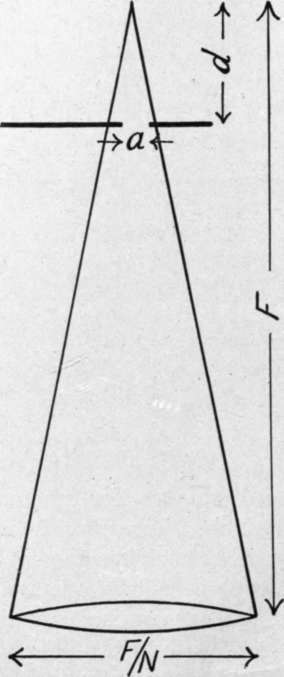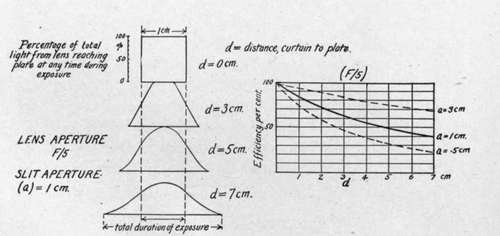Characteristics Of The Focal Plane Shutter
Description
This section is from the book "Airplane Photography", by Herbert E. Ives. Also available from Amazon: Airplane photography.
Characteristics Of The Focal Plane Shutter
Long before the days of aerial photography the problem of a high be F/N, the width of the slot be a, and the distance from plate to curtain d (Fig. 21). Now if the curtain is moving at a uniform speed, the time taken for the slot to traverse the whole cone of rays, from the instant it enters till the instant it leaves, will be directly proportional to off rapidly with distance, especially so for small apertures of the slot.

Fig. 21. - Calculation of focal plane shutter efficiency.
The efficiency of the focal-plane shutter may be calculated as follows: Let the focal length of the lens be F, its diameter.
As an example let the lens aperture be F/6, so that N=6; let d=l, and a=l, then E=6/7 In tne Erench de Maria cameras, where d=4 centimeters, 12=60 per cent, for the aperture assumed, which is representative. Fig. 22 exhibits diagrammatically the chief characteristics of the focal plane shutter.

Fig. 22. - Characteristics of focal plane shutter.
In view of the necessity for some distance between shutter.
If the curtain were in contact with the plate the time taken for the same amount of light to reach the sensitive surface would be proportional to a. Again defining shutter efficiency as the ratio of the light transmitted to what would have been transmitted were the shutter fully open for the total time of exposure, the efficiency, E, is given at once by the expression— and plate it is obviously important to keep a as large as possible, depending for the requisite shutter speed on the velocity of the curtain. Large aperture and high curtain speed are also found to be desirable when we consider the distortion produced by the focal-plane shutter.
Continue to:
- prev: Characteristics Of Shutters Located At The Lens
- Table of Contents
- next: Distortions Produced By The Focal Plane Shutter
Tags
camera, lens, airplane, aerial, film, exposure, photography, maps, birdseye
